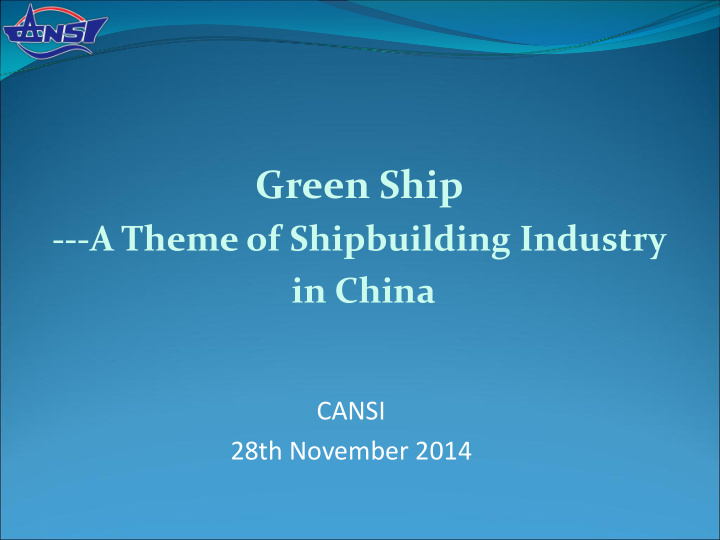



Green Ship ---A Theme of Shipbuilding Industry in China CANSI 28th November 2014
Content 1. The Development of China Shipbuilding Industry 2. Current Challenges 3. Priority of Shipbuilding Industry in China 2
Content 1. The Development of China Shipbuilding Industry 2. Current Challenges 3. Priority of Shipbuilding Industry in China 3
The Development of China Shipbuilding Industry According to statistics published by CANSI , there were 815 shipbuilding companies in China in 2013, with the completion of 45.34 million DWT, accounting for 41.4%.The total new orders of ships undertook by shipbuilding enterprises in China amounted to 69.84 million DWT (47.9%). The amount of holding orders in Chinese shipbuilding enterprises was 131 million DWT (45.9%) New Orders Orderbook Completion 4
The Development of China Shipbuilding Industry From January to October of 2014, the completion volume of ships in China was 30.50 million DWT (33.2%) . China received orders of 46.56 million DWT (49.1%) and kept existing orders of 155.48 million DWT (48.1%) Overview of the Shipbuilding Market 2014.01~10 5
Content 1. The Development of China Shipbuilding Industry 2. Current Challenges 3. Priority of Shipbuilding Industry in China 6
Challenge 1: Cheap oil is the past thing In present, fuel cost accounts for 50% to 70% of the total operating cost. In future, the oil price will stay strong, unlikely to decrease in large scale. Source: EIA, International Energy Outlook 2014
Challenge 2: Overcapacity The overcapacity coexists in both shipbuilding industry and shipping industry. For the years to come, the demand of ships will remain weak. As a result, China shipbuilding industry and even the global shipbuilding industry at large have to face such an unprecedented challenge.
Challenge 3: Ship emission threatens human life The Greenhouse Effect, Ozone Depletion, Acid Rain Spread, Land Desertification, Air Pollution, water pollution, Marine Pollution ... The emission of ships are deteriorating those crises, greatly threatening humans. A large containership using 3.5% sulfur fuel oil , sailing at 70% of the maximum loading power could emit PM2.5 equivalent to 500 thousand trucks a day.
Challenge 4: IMO Regulations IMO SRC AFS MARPOL BWM SOLAS Harmful Aquatic Organisms Hazardous materials in Ballast Water EEDI 、 EEOI 、 SEEMP 、 NOx 、 SOx 、 PM/Black Carbon
Content 1. The Development of China Shipbuilding Industry 2. Current Challenges 3. Priority of Shipbuilding Industry in China 11
Green Ship as the Thematic Guidance In the context of industrial restructuring of shipping and shipbuilding industry over the next 10 to 20 years, China shipbuilding industry is committed to deepening structural adjustment and taking reforming as motive force to promote the development. We focus far more on quality, efficiency and cost effectiveness, and persist in the course of efficient, green and sustainable development. Therefore, developing the green ship technology becomes thematic guidance in China.
What is green ship? The elements of green ship include: Environment Efficiency Human health Construction Operation Recycling Design
How to Make the Ultimate Green Ship The Chinese shipbuilders pay more attention to technologies on saving the consumption of materials and energy without affecting the quality and navigation safety. For 2016 MGO (Marine Gas Oil) Better Hull Line Design EGR and SCR ESD Design Coating Selection Engine Loading Optimization Propeller Optimization For 2020 Pure LNG or Scrubber? Low Speed for EEDI phase II?
NEW ENVIRONMENTAL REGULATIONS AND TECHNICAL SOLUTIONS BALLAST SOx NOx CO2 WATER TARGET APPROACH TECHNICAL MEASURE ECA GLOBAL Nox EEDI ENERGY D-2 0.1%S 0.5%S TIER Ⅲ Phase2 EFFICIENCY Standard 2015 2020 2016 2020 Always Upcoming Hull shape optimization Energy saving device Hull Large diameter propeller Lightweight optimization Advanced A/F coating Energy saving Reducing installed power(SMCR) "G"type or "X"type M/E Derating/Low RPM Machinery Part or low load optimization Waste heat recovery system Auxiliary Systems Optimization HFO + LSFO(0.1%S) within ECA LSFO(0.1%S) within ECA + LSFO(0.5%S) in global Fuel strategy HFO + SOx scrubber Environmental HFO + LNG within ECA protection Pure LNG as fuel Selective catalytic reduction(SCR) Equipment Exhaust gas recirculation(EGR) Ballast water treatment system Benefit Adverse
Hull Lines Optimization Performance prediction by CFD Validation by model test NOVEL BOW SHAPE
Energy Saving Device Designed by MARIC DUCT SAVING ENERGY: + 4~6% RUDDER FIN Manufactured by shipyard
Lightweight Optimization Harmonized CSR: 1st July 2015, enter into force. Optimized design: - Lines and loading condition - Structural Arrangement - Scantling optimization - Detail optimization, especially for anti-fatigue - Higher tensile steel - Workmanship
NOx Control EGR SCR Internal engine After-treatment method SFOC increased SFOC increased 4g/kwh at 100%MCR 0.5g/kwh 3.5g at 85% at 75%-100%MCR 2g at 50% 1-2g at low load 5-13kw/MW SMCR 5kw/MW SMCR Engine aft part Engine fore part arrangement arrangement Ammonia Urea only for MAN Additional System Additional System MAN MAN WARTSILA Not available for A.E. Available for A.E.
Energy-Saving Design HANDYSIZE PANAMAX Bulk lk Carrier ier CAPSIZE VLOC 20
208,000 DWT NEWCASTLE MAX 67.0 T -27% 27% 48.8 T DFOC EEDI 21% BELOW BASELINE
180,000 DWT DUNKIRK MAX 57.0 T -16% 16% 47.4 T DFOC EEDI 15% BLOW BASELINE
82 ,000 DWT KAMSARMAX 37.8 T -29% 29% 26.7 T DFOC EEDI 13% BELOW BASELINE
64 ,000 DWT ULTRAMAX 34.50 T 24.70 T -28% 28% DFOC EEDI 18% BELOW BASELINE
38 ,000 DWT HANDYSIZE 24.80 T 17.60 T -29% 29% DFOC EEDI 25% BELOW BASELINE
Tanke nker r series ies VLCC Aframax MR 26
318,000 DWT VLCC 104.70 T -24% 24% 79.9 T DFOC EEDI 20% BELOW BASELINE
113,000 DWT AFRAMAX 49.10 T 37.80 T -23% 23% 新船 DFOC EEDI 28% BELOW BASELINE
50 ,000 DWT CHEMICAL TANKER 34.50 T -35% 35% 22.26 T DFOC EEDI 29% BELOW BASELINE
Cont ntainer ainer Vessel ssel PANAMAX FEEDER VLCS 30
9400 TEU VLCS 249 T 155 T -38% 38% DFOC EEDI 40% BELOW BASELINE
2200 TEU CONTAINER VESSEL 77.5 T 46.5 T -31T 31T DFOC EEDI 29% BELOW BASELINE
Conclusion Promote tight cooperation on green technology among Asian shipbuilding experts; Pay more attention to regulations, standards and rules; Work closely with Class and Shipowners;
Thanks 35
Recommend
More recommend